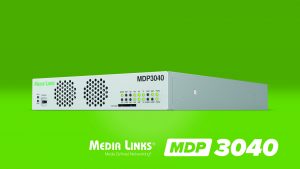SVG Europe Sit-Down: Media Links’ Mark Podesla reveals IBC plans and offers IP predictions
 IP-based technology from Media Links has been the backbone of soccer World Cups, winter and summer Olympic events, major US American Football events, Asian Games, and many other high-profile global sporting events since 2002. In each case, the Media Links solutions have been used by major broadcasters to transport broadcast signals from these events to destinations around the globe. It’s all part of the company’s vision, as Mark Podesla, senior manager – product management/marketing, explains…
IP-based technology from Media Links has been the backbone of soccer World Cups, winter and summer Olympic events, major US American Football events, Asian Games, and many other high-profile global sporting events since 2002. In each case, the Media Links solutions have been used by major broadcasters to transport broadcast signals from these events to destinations around the globe. It’s all part of the company’s vision, as Mark Podesla, senior manager – product management/marketing, explains…
Your website states that Media Links was founded on a vision. Can you tell us more about that vision – and how you are fulfilling it?
More than 20 years ago Media Links was founded on the singular vision that multi-service IP networking is the most flexible and robust method of transporting broadcast video and media over both local and wide area networks. Since those early times, the company has not wavered in its approach to IP transport and switching solutions. Time and again, our customers and the television industry at large have validated the effectiveness of our approach. As video continues to evolve, our IP-based encoding, decoding, transport and switching solutions continue to keep pace with higher and more demanding media formats such as 4K UHD, HDR video and 10G hitless data. Our active role in the industry’s standards bodies provide us the opportunity to further influence and shape the evolving IP-centric media specifications that will be here in the years to come.
How do you assess the appetite for your products?
Media Links is seeing increased demand for its products on several fronts. For many customers, baseband SDI routing is running out of steam and bandwidth, necessitating significant capital expenditures to upgrade ageing studio, production, and networking switches. To support applications like remote/at-home production, file transfers, replays, and more, broadcasters are also consuming more data-centric services than ever before. Maintaining separate SDI and IP data networks may have made sense in the past, but in 2018, a converged IP network is much more compelling from an equipment and operational workflow standpoint. New layered services that ride on top of IP such as SMPTE 2110 further strengthen this value proposition.
What can we expect to see on your stand at IBC?
On Stand 1.C31 Media Links will showcase its new family of 100G media-centric IP switches, which address the requirements of accelerated IP workflows and necessary infrastructure upgrades that are essential for new network bandwidth demands. They deliver high port density enabling facilities to operate at any scale while reducing operational costs and infrastructure complexity.
These 100G switches are available in two versions; a 32-port version with a switching capacity of 6.4 Tbps and a forwarding rate of 4.7 Bpps and a 48-port version with a switching capacity of 1.8 Tbps and a forwarding rate of 2.7 Bpps. To achieve extremely fast switching times in the network, these switches use a combination of “Flow” technologies to set-up and tear-down connections.
 Part of the Media Links MDX switch family, these 100G switches are designed specifically for processing multicast media streams whether compressed, uncompressed, and/or bi-directional. They are optimised for zero packet loss, 100 per cent throughput, maximum forwarding rate, and allocating memory to priority queues. A specially designed embedded LSI switch controller ensures full bandwidth on every port to every other port.
Part of the Media Links MDX switch family, these 100G switches are designed specifically for processing multicast media streams whether compressed, uncompressed, and/or bi-directional. They are optimised for zero packet loss, 100 per cent throughput, maximum forwarding rate, and allocating memory to priority queues. A specially designed embedded LSI switch controller ensures full bandwidth on every port to every other port.
With a switching capacity up to 6.4 Tbps, high port density, support for both L2 and L3 layers, a compact 1RU form factor and low power consumption, the MDX 100G switching series provides a scalable and efficient solution for facilities transitioning to 4K and IP video routing. Since all of Media Links’ switching solutions are media-centric, its products go beyond off-the-shelf COTS switches, and are tailored to the demanding needs of broadcast media traffic over an IP network.
The MDX 100G Series also addresses the market demand for bi-directional media data, especially for remote production applications. Traditional baseband switches cannot easily handle this type of IP media traffic, whereas the MDX 100G switches can. Plus, they transport data traffic hitlessly while protecting against loops, which is something traditional network switches pay little or no attention to. Other key features include VLAN bridging and translation, special QoS services, as well as LLDP (Link Layer Discovery Protocol) support.
The new MDP3040 IP Media Gateway, part of the MDP3000 Series of standalone edge devices will also make its debut at IBC, stand 1.C31. This multi-channel device serves as a standalone 4K UHD encoder/decoder utilising TICO compression, supporting two channels of 12G-SDI.
Dual 10G trunks and hitless switching provide the highest levels of redundancy and video protection. Due to its combination of high performance and versatility, broadcasters can use the MDP3040 for both remote venue and in-studio applications.
Our existing MDP3020 standalone edge gateway will also be on display with some new feature enhancements. These include two channels of video plus audio, as well as two channels of bi-directional hitless data. Both uncompressed – 3G/HD/SD-SDI – and JPEG 2000 compressed video processing are supported, as are 1Gbps or 10Gbps fibre trunks. The unit’s LLDP trunk diagnostic and keepalive mechanism interoperates with Media Links’ MD8000 product family, MDX switches as well as other MDP3020 units.
A new 1 RU redundant power supply capable of powering up to eight MDP3040 or MDP3020 units will also be introduced.
What next when it comes to the use of IP? Where will the broadcast industry be this time next year?
Several clear-cut themes are starting to emerge from today’s IP landscape. With the need to transport more camera feeds, higher bandwidth 4K signals, and more data, 10Gb switch interconnects and metro LAN and WAN trunk circuits are reaching their capacity limits. From both a technical and business perspective, it makes sense for many end users to migrate to 40Gb aggregation and 100Gb core switches. Cost effective, higher bandwidth, and media-optimised – as opposed to generic data – switches along with end-to-end timing and control are making this transition easier, achievable and more affordable.
2020 could see more interest being shown in 8K. What preparations are you making to support any such move?
The Japanese market is one of the major driving forces behind the adoption of 8K, with several high-profile broadcasters leading the charge. The 2020 Summer Games in Tokyo will significantly expand the use of 8K. And as you may know, we have a very close working relationship with the Japanese broadcasters as well as numerous equipment manufacturers, so we are carefully watching and positioning ourselves for the evolution of 8K.
From the 2018 Winter Games and recent World Football Games in Russia, we have some strong 4K transport experience under our belts. Our products were integral and worked tremendously well for these premier events, so we’ll leverage this expertise in preparation for supporting 8K.
Any future plans you can discuss?
Media Links continues to refine its soft SDI to IP migration solutions, providing an evolutionary and seamless path for media switching and transport over a common LAN/WAN IP architecture. With 100GB switching at the core and 10/25/40 Gb aggregation, bandwidth constraints effectively go away, allowing new services for all video/media types like 4K UHD and remote/distributed production. With low latency, SDI-like performance/operation, synchronous network timing, configurable QoS, and hitless/seamless protection, broadcasters can rest assured that Media Links IP switching and transport solutions will continue to meet their highest production standards and requirements.
Do you have a sports related case study that illustrates your solutions?
At the recent 2018 World Football Games in Russia, Media Links MD8000 and MDP3020 equipment played an essential role in the IP video transport network, supplying eighty plus 3G/1080i and nearly a dozen 4K UHD feeds between each of the twelve remote stadiums and IBC (International Broadcast Centre) outside Moscow.
From initial test and turn-up to live operations, the network management, monitoring, and diagnostics were performed using the company’s ProMD Enhanced Management System (EMS). The MDP3020 units featured dual hitless 10Gbps trunk connections and were specifically used to remotely control the playback speed of slow-motion replay servers for both officials and referees in all the stadiums, assisting them in improving the accuracy of their critical game calls.

